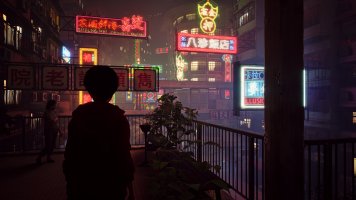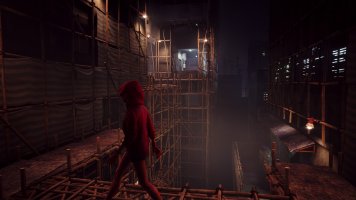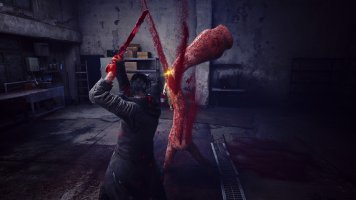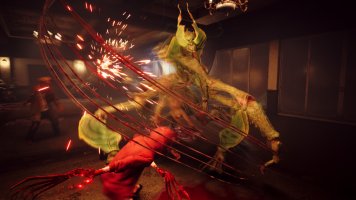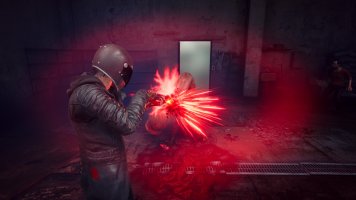General Information
The game excels in multiple areas, from its intricate body-hopping combat system to its atmospheric recreation of 1990s Hong Kong. Players will discover a deep narrative exploring moral complexity, enhanced by striking monster designs and a haunting soundtrack that amplifies the tension throughout the experience. This review examines how Slitterhead pushes boundaries in horror gaming while maintaining a distinct identity.
Gameplay Mechanics: Possession and Combat
At the heart of Slitterhead's innovative gameplay lies a unique possession system where players control Hyoki, a disembodied spirit capable of inhabiting various hosts throughout the neon-lit streets of Kowlong.
Body-hopping mechanic
The possession system transforms traditional combat encounters into dynamic strategic puzzles. As Hyoki, players can seamlessly transition between different hosts, using each body as a temporary vessel in their fight against the monstrous Slitterheads. This mechanic isn't just a gimmick – it's a core survival strategy. When a host's health depletes, quick thinking and precise timing in switching to another body can mean the difference between victory and defeat.The possession mechanic extends beyond combat, offering creative solutions for exploration and infiltration. Players can strategically possess different civilians to access restricted areas or gather intelligence, making every NPC in the game a potential tool in Hyoki's arsenal.
Blood-based weapons and abilities
Combat in Slitterhead revolves around a fascinating blood weapon system. Each possessed host can transform their blood into lethal weapons, creating a unique risk-reward dynamic where health serves as both defense and offensive resource. Blood weapons manifest in various forms:| Weapon Type | Characteristics | Best Use Case |
|---|---|---|
| Claws | Close-range, rapid attacks | Aggressive combat |
| Spears | Mid-range precision strikes | Crowd control |
| Plasma Swords | High damage, HP intensive | Boss encounters |
The system encourages aggressive play while maintaining tension through resource management. Players must carefully balance their blood usage between attacks and survival, adding a strategic layer to every encounter.
Rarity characters and their unique skills
Beyond standard hosts, Slitterhead introduces special characters known as "Rarities" who possess extraordinary abilities when controlled by Hyoki. These characters serve as powerful assets in combat and story progression. Notable Rarity abilities include:- Julee's Revive All: Recovers blood levels and heals nearby allies
- Alex's Blood Well: Creates gravity fields to control enemy positioning
- Blake's Bloody Shot: Deploys a devastating blood-based machine gun
- Betty's Indomitable: Significantly boosts defense and counter-attack potential
The combat system truly shines when players master the interplay between standard possession, blood weapons, and Rarity abilities. Blood Time, a special slow-motion state activated through perfect parries, adds another layer of tactical depth, allowing players to carefully choose their next host or set up devastating combination attacks.
Story and Setting: Kowlong's Dark Underbelly
Deep within the neon-drenched streets of Kowlong, a fictional metropolis that masterfully blends the essence of 1990s Hong Kong and Kowloon, unfolds a tale of supernatural horror and moral complexity.
1990s Hong Kong-inspired world
Kowlong emerges as more than just a backdrop—it's a living, breathing character in its own right. The city perfectly captures the zeitgeist of 1990s Asian urbanization, where tradition and modernity clash in fascinating ways. The setting is divided into distinct districts:| District Type | Characteristics | Atmosphere |
|---|---|---|
| Business Quarter | Neon-lit facades, modern architecture | Bustling, energetic |
| Traditional Areas | Ancient temples, markets | Mysterious, cultural |
| Slum Districts | Narrow alleys, dense housing | Claustrophobic, tense |
The game's creator, Keiichiro Toyama, drew inspiration from Wong Kar-wai's cinematic portrayals of Hong Kong, incorporating vivid colors and noisy textures that create an intoxicating atmosphere of nostalgia and danger.
Slitterheads and their motivations
The titular Slitterheads present a terrifying threat to Kowlong's population. These parasitic entities, inspired by Chinese mythology's Yegouzi, are brain-consuming monsters that can perfectly disguise themselves as humans. Their presence is revealed through subtle environmental cues—disturbed air currents and atmospheric anomalies that add a layer of paranoid tension to every encounter.Key story elements revolve around:
- Mysterious murders with victims found brainless in back alleys
- A three-day time loop that players must navigate to uncover the truth
- Hidden memory fragments that piece together the larger narrative
- Environmental storytelling through the city's changing atmosphere
Moral ambiguity and character development
The narrative weaves a complex web of relationships and motivations, centered around the player character—a mysterious spiritual entity known as Hyoki. As an amnesiac force investigating the Slitterhead menace, Hyoki's journey mirrors the city's own duality. The story unfolds through multiple perspectives as players interact with Rarities—special characters whose individual plights and histories gradually illuminate the darker aspects of Kowlong's supernatural ecosystem.The time-traveling narrative structure adds depth to character development, allowing players to revisit key moments and potentially prevent tragic events. This mechanic serves a dual purpose: advancing the plot while providing opportunities to explore different moral choices and their consequences.
The investigation spans approximately 13 hours, during which players must piece together not only the mystery of the Slitterheads but also uncover Hyoki's own origins. The story raises provocative questions about identity, humanity, and the thin line between predator and prey. Moral choices throughout the game aren't simply black and white—they reflect the complex nature of survival in a city where both humans and monsters struggle to coexist.
What makes the narrative particularly compelling is how it interweaves personal stories with larger themes. Each Rarity character brings their own motivations and backstories, from Julie's mysterious revival to Alex's determined hunt for Slitterheads. These personal narratives contribute to a larger tapestry of survival, revenge, and redemption within Kowlong's supernatural ecosystem.
Visual and Audio Design: A Haunting Atmosphere
The visual and audio presentation of Slitterhead creates an unforgettable atmospheric experience that masterfully blends supernatural horror with urban decay. The game's artistic direction serves as a powerful vehicle for its narrative and gameplay elements, creating a uniquely immersive world.
Gritty urban environments
Kowlong's environment design captures the essence of 1990s urban Asia with remarkable attention to detail. The city's architecture creates a stark contrast between:| Area Type | Visual Elements | Atmospheric Effect |
|---|---|---|
| Street Level | Neon signs, rain-slicked pavements | Cyberpunk noir esthetic |
| Back Alleys | Dense urban sprawl, cluttered spaces | Claustrophobic tension |
| Rooftops | Towering structures, ambient lighting | Vertical exploration |
The environmental design excels in creating a sense of place through expert lighting and densely layered details. Each return to familiar locations reveals new visual elements, making the repeated exploration of areas feel fresh and purposeful. The game's mise-en-scene pulls together repeated assets and limited animations into something stronger than their individual components, creating a cohesive and memorable world.
Monster designs and transformations
The Slitterhead creatures represent some of the most innovative monster designs in recent horror gaming. Their transformations abandon traditional humanoid body horror conventions, instead opting for creative and unsettling metamorphoses. The visual design team has crafted creatures that can:- Maintain human facades until the moment of revelation
- Transform through multiple stages of grotesque mutation
- Display unique anatomical designs that defy conventional monster tropes
Soundtrack and sound effects
Akira Yamaoka, renowned for his work on Silent Hill, brings his considerable talent to Slitterhead's soundscape. His approach distinguishes between what he terms "Real" and "Reality" in the audio design. While modern hardware capabilities allow for realistic sound reproduction, Yamaoka's composition goes beyond mere realism to evoke deeper emotional responses.The audio design features several distinctive elements:
- Ambient Soundscape
- Custom-created drone sounds avoid standard audio assets
- Organic and varied environmental audio
- Unique sound identity for each district of Kowlong
- Character Audio
- Distinct sound profiles for Hyoki and Slitterheads
- Subtle audio cues for transformation sequences
- Minimal human vocalizations for enhanced impact
The game's audio-visual synergy reaches its peak during combat encounters, where the transformation sequences of Slitterheads are accompanied by carefully orchestrated sound design that amplifies the horror of their metamorphosis. Environmental audio plays a crucial role in building tension, with subtle sound cues warning players of impending dangers and helping to create a constant state of unease.
The visual presentation, while occasionally showing its budget constraints in character animations and some environmental assets, succeeds in creating a compelling atmosphere. The city streets effectively capture the intended 90s neon esthetic, particularly during rain-soaked night sequences. While some character models might appear dated by current standards, the artistic direction compensates through strong environmental design and memorable monster transformations.
What truly elevates Slitterhead's presentation is how the visual and audio elements work in concert to create a cohesive atmosphere. The game's unique identity emerges from this careful balance of sight and sound, where Yamaoka's distinctive score complements the visual horror rather than overwhelming it. This synergy creates an immersive experience that draws players into Kowlong's supernatural underbelly, making every encounter with the Slitterheads a memorable fusion of visual spectacle and auditory terror.
Conclusion
Slitterhead masterfully weaves together possession-based gameplay mechanics, atmospheric storytelling, and haunting audiovisual design into a compelling horror experience. The game's blood weapon system and strategic body-hopping mechanics create dynamic combat scenarios, while the richly detailed streets of Kowlong transport players into a supernatural version of 1990s Hong Kong. Through its morally complex narrative and memorable Rarity characters, the game builds a deeply engaging world where survival demands both tactical skill and careful decision-making.
The remarkable fusion of Akira Yamaoka's atmospheric soundtrack with striking monster designs and transformations establishes Slitterhead as a standout title in the horror-action genre. Players will find themselves drawn into a dark yet captivating world where traditional horror conventions meet innovative gameplay systems. This bold reimagining of survival horror proves that fresh ideas and atmospheric storytelling can breathe new life into the genre while respecting its roots.


